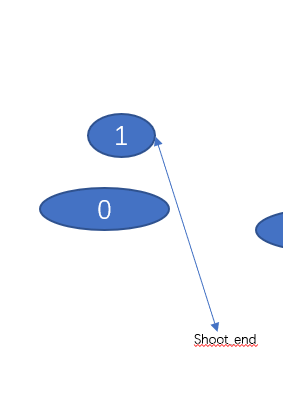热门标签
热门文章
- 1缓存相关问题记录解决
- 2JAVA(SpringBoot)对接微信登录_java对接微信登录
- 3三、若依登录功能(按钮)前、后端代码详解
- 4【MySQL】学习如何通过DML更新数据库的数据
- 5C语言面向对象编程(一):封装与继承_c 语言 面向对象继承
- 6Python编程技巧 – 单字符函数
- 7vue2 百度地图点聚合_vue2 百度地图实现点聚合
- 8编程练习【二叉树的中序遍历】_root = [1,null,2,3]
- 97,二叉树按二叉链表形式存储,写一个判别给定二叉树是否是完全二叉树的算法。_对于一颗用二叉链表存储的二叉树,用c语言写一个递归函数判别该二叉树是否完全
- 10java 学生信息管理系统Myeclipse开发mysql数据库web结构jsp编程计算机网页项目_javaweb学生信息管理系统mysql+eclipse
当前位置: article > 正文
【PPT解leetcode 452】射击气球_leetcode ppt
作者:数据可视化灵魂 | 2024-01-30 18:33:15
赞
踩
leetcode ppt
1.排序
使用sort(points.begin(),points.end());默认是对二维数组第一列进行升序排列,即气球的左坐标从小到大排列,并且将shoot_end初始化为第一个气球的右坐标。

接下来对后面每个气球进行遍历,比较第i个气球的左边界和是否小于shoot_end(第一次比较end_shoot即为0气球的右坐标)
2.接下来有两种情况
第一种是,新气球的左边界的坐标大于shoot_end,这时候表明,需要增加一个枪手,并且需要更新shoot_end为新气球的右坐标;图示为1号气球的左坐标大于shoot_end,此时代表需要增加一个枪手,并且再将1号气球的右坐标作为shoot_end。

第二种情况是不需要新添枪手,即新气球的左坐标,小于shoot_end,表明两个气球有重叠区域,这时候仅需要更新shoot_end即可,新shoot_end为重叠区域的右坐标,即
min(shoot_end,points[i][1])


更新shoot_end为重叠区域的右坐标
完整代码
class Solution { public: int findMinArrowShots(vector<vector<int>>& points) { if(points.size()==0) { return 0; } std::sort(points.begin(),points.end()); //sort()函数,默认的是对二维数组按照第一列进行排序。VIA[i][0],这一列。 int shoot_end=points[0][1]; int shoot_num=1; for(int i=1;i<points.size();i++) { if(points[i][0]>shoot_end) { shoot_num++; shoot_end=points[i][1]; } else { shoot_end=min(shoot_end,points[i][1]); } } return shoot_num; } };
- 1
- 2
- 3
- 4
- 5
- 6
- 7
- 8
- 9
- 10
- 11
- 12
- 13
- 14
- 15
- 16
- 17
- 18
- 19
- 20
- 21
- 22
- 23
- 24
- 25
- 26
- 27
- 28
- 29
声明:本文内容由网友自发贡献,不代表【wpsshop博客】立场,版权归原作者所有,本站不承担相应法律责任。如您发现有侵权的内容,请联系我们。转载请注明出处:https://www.wpsshop.cn/article/detail/47725
推荐阅读
相关标签




